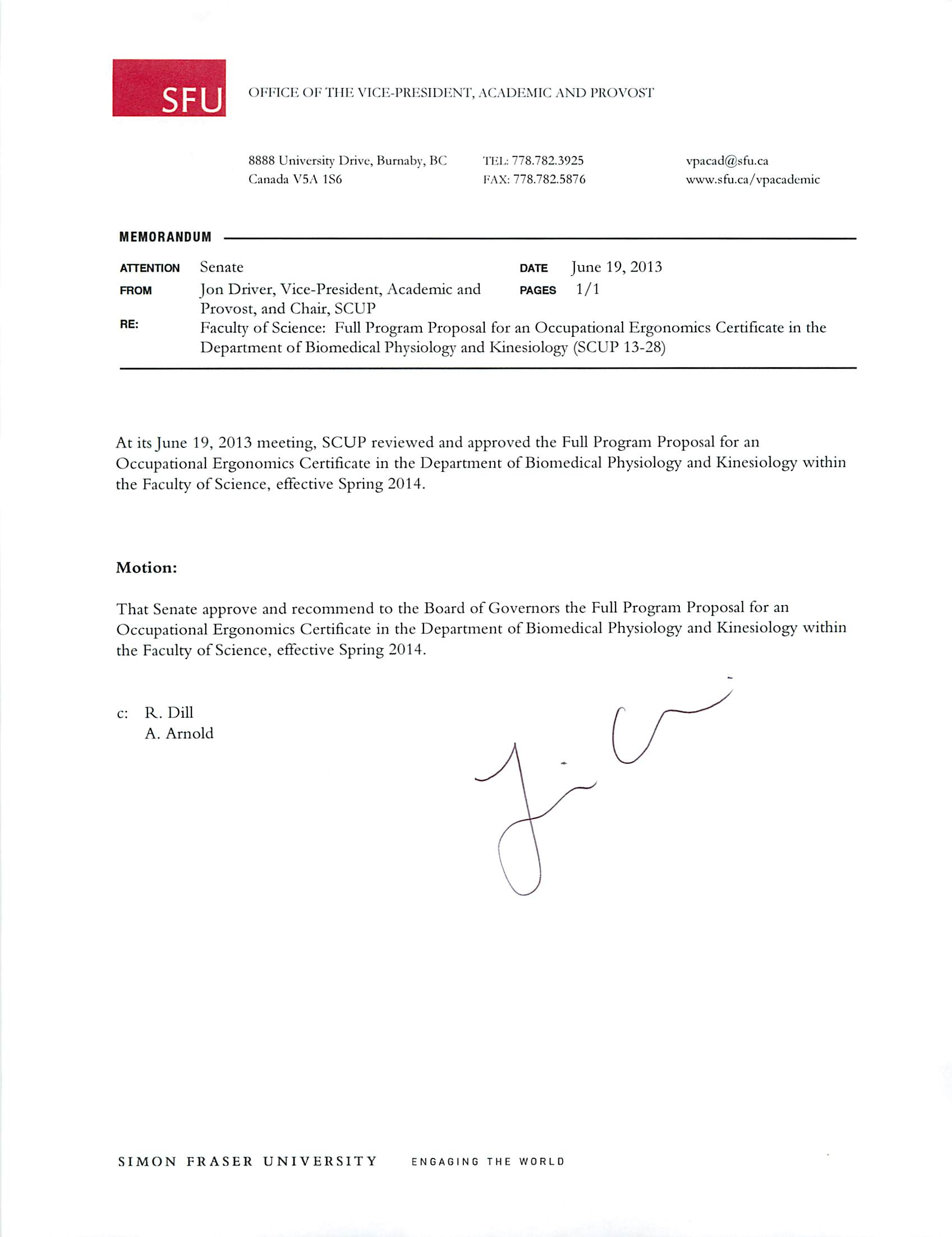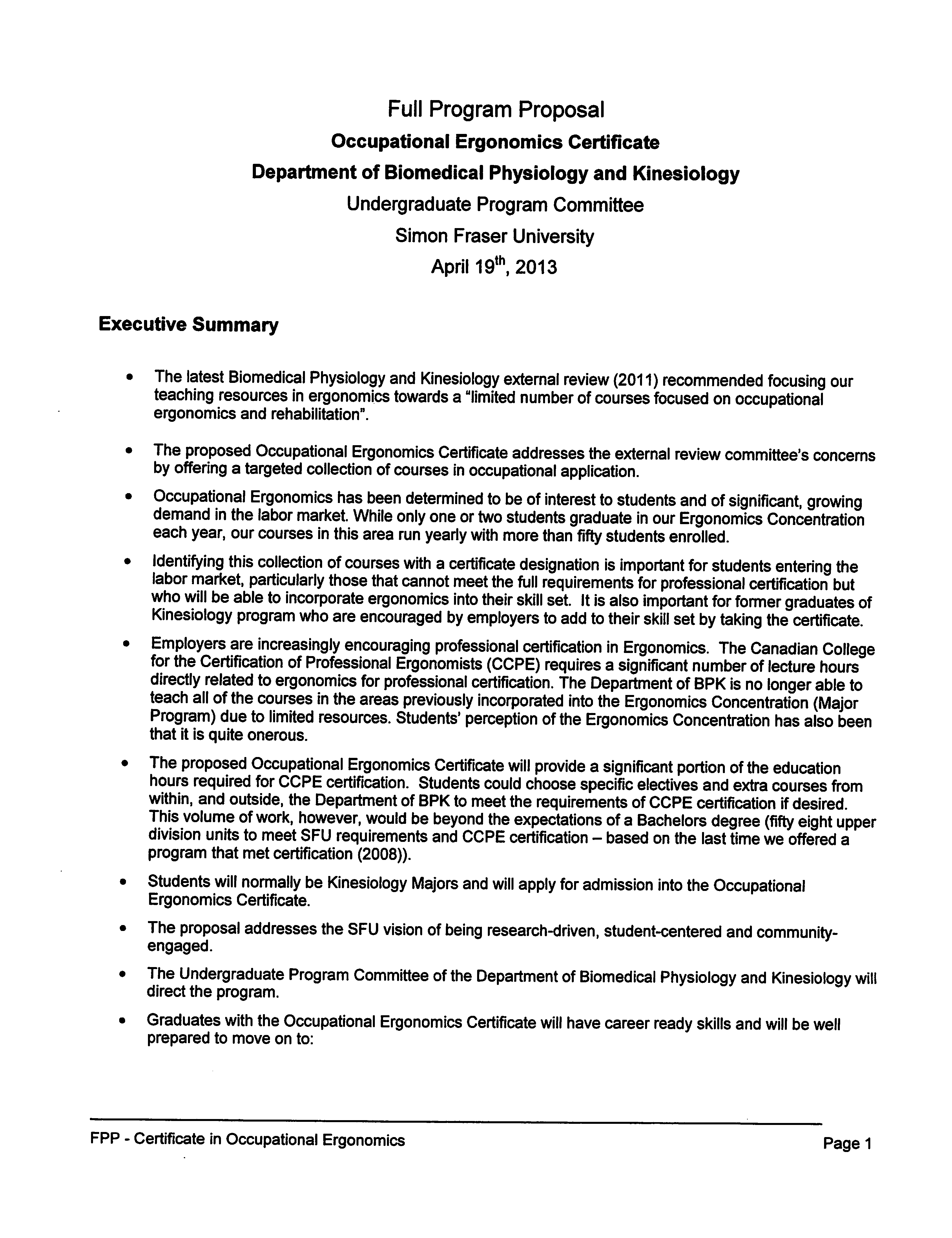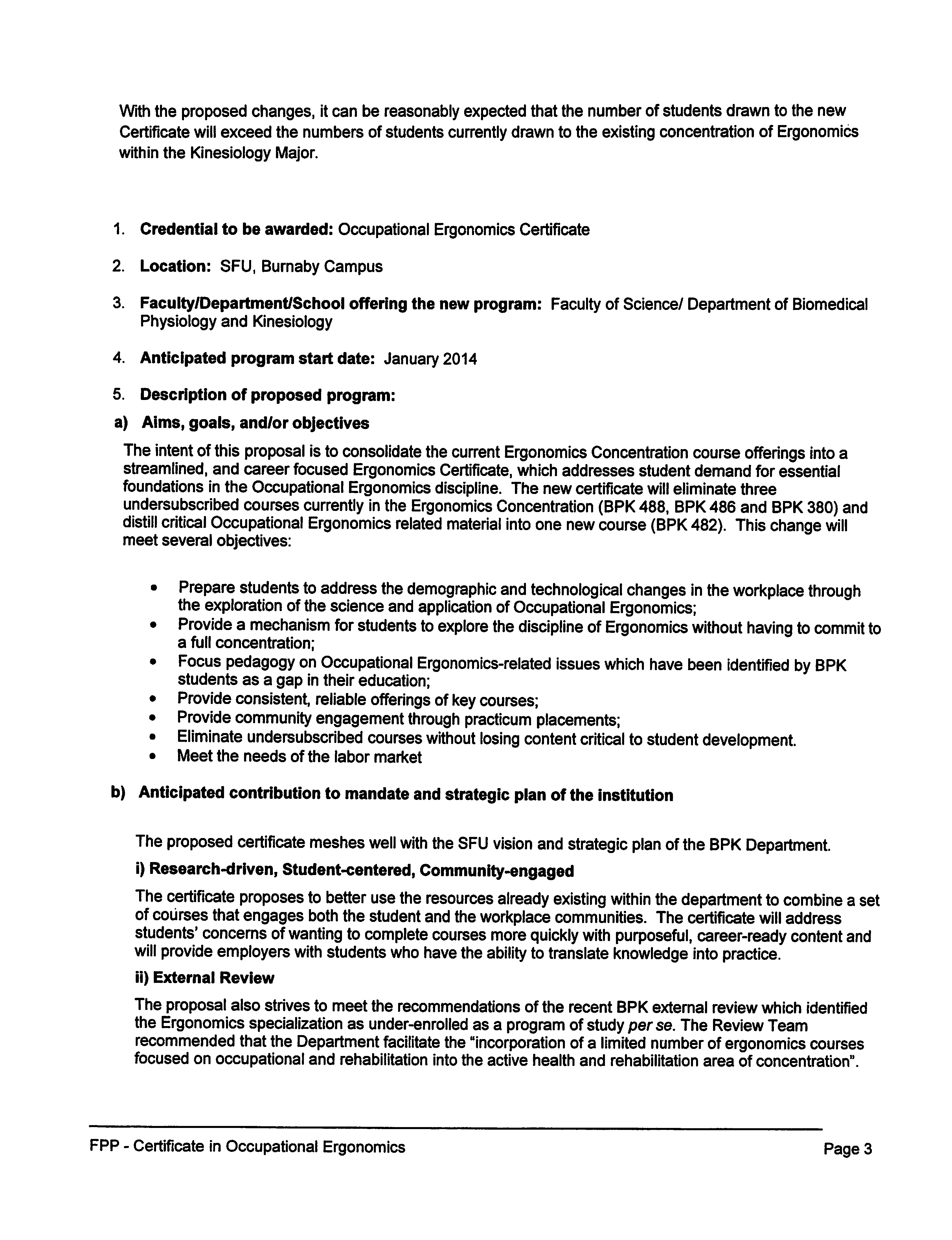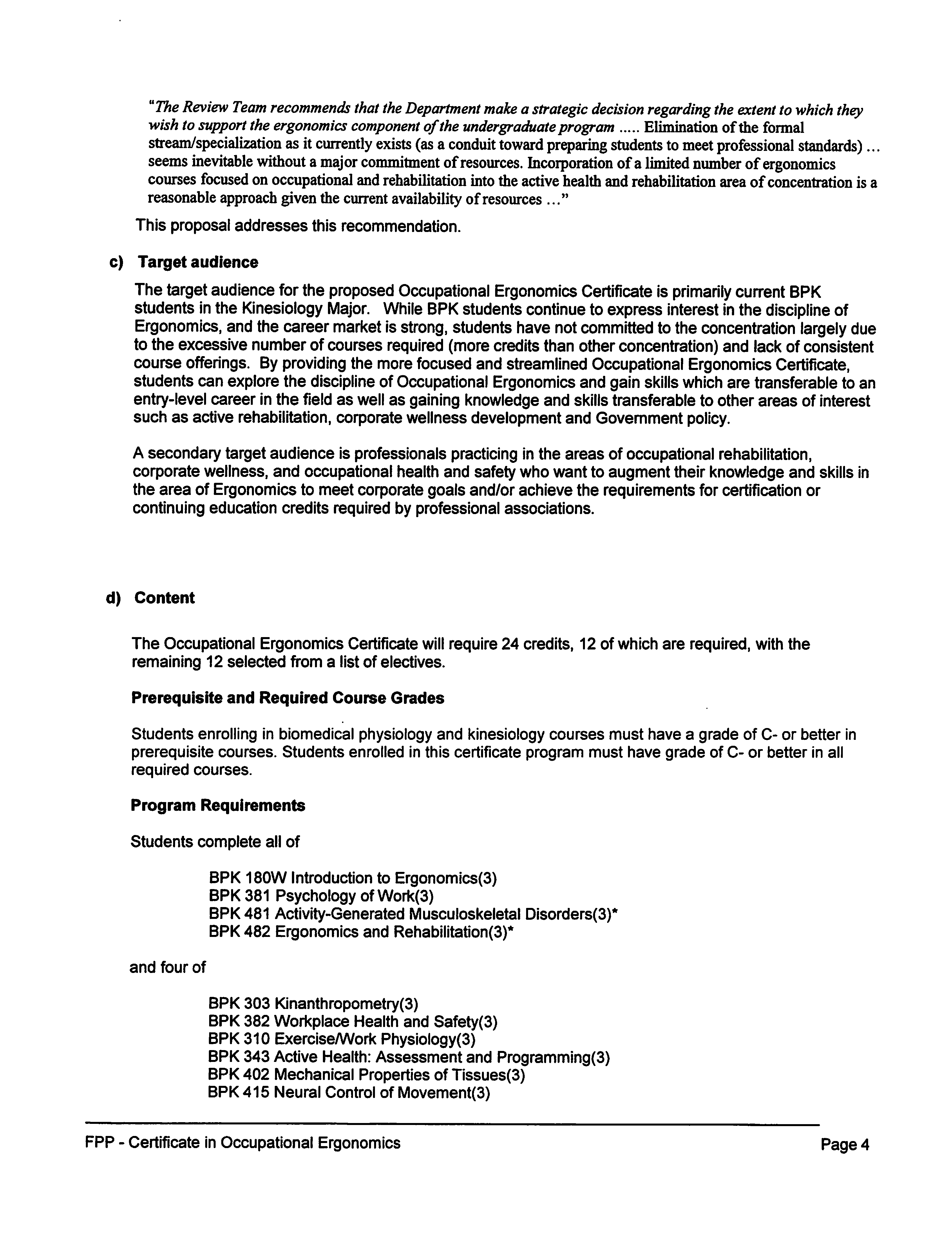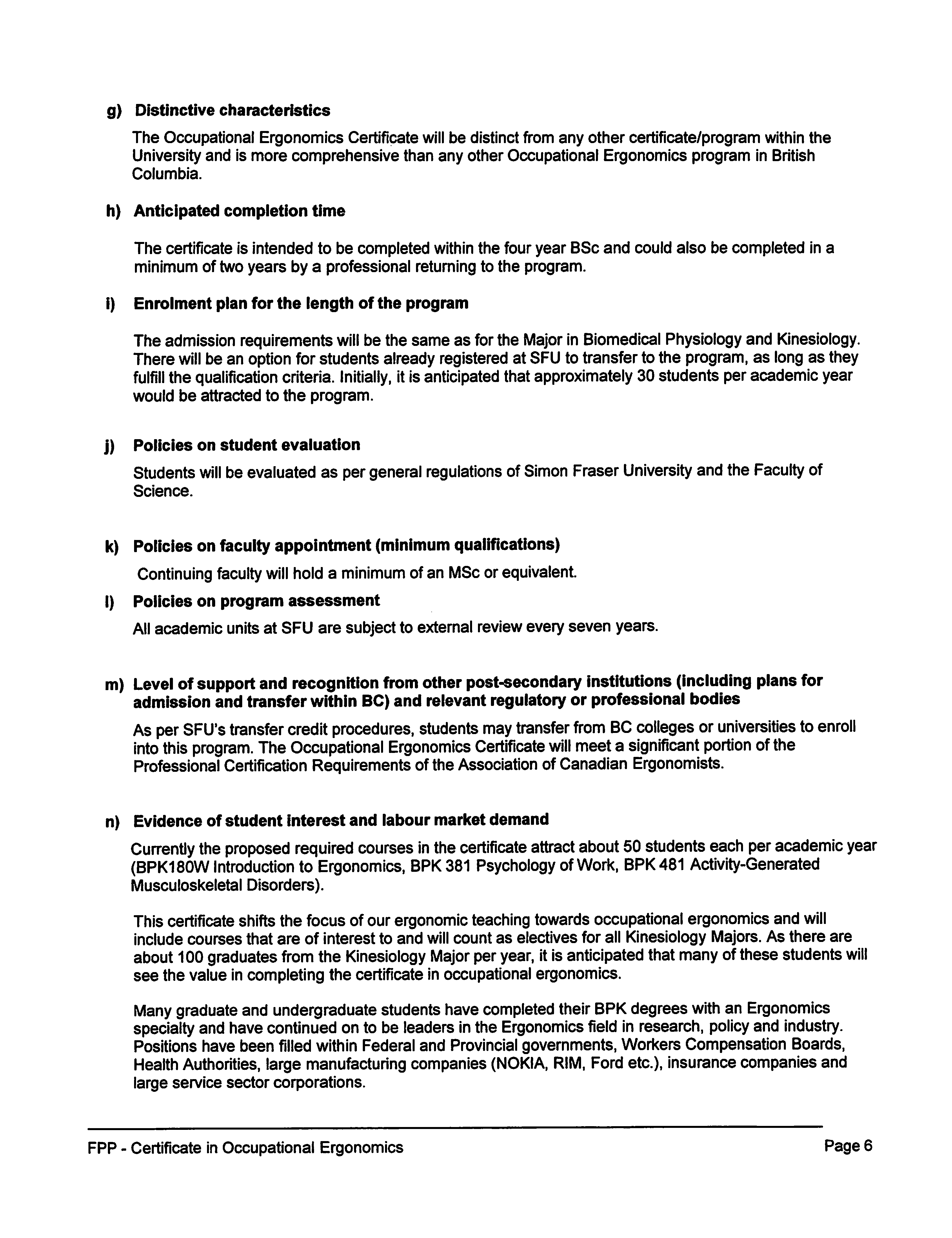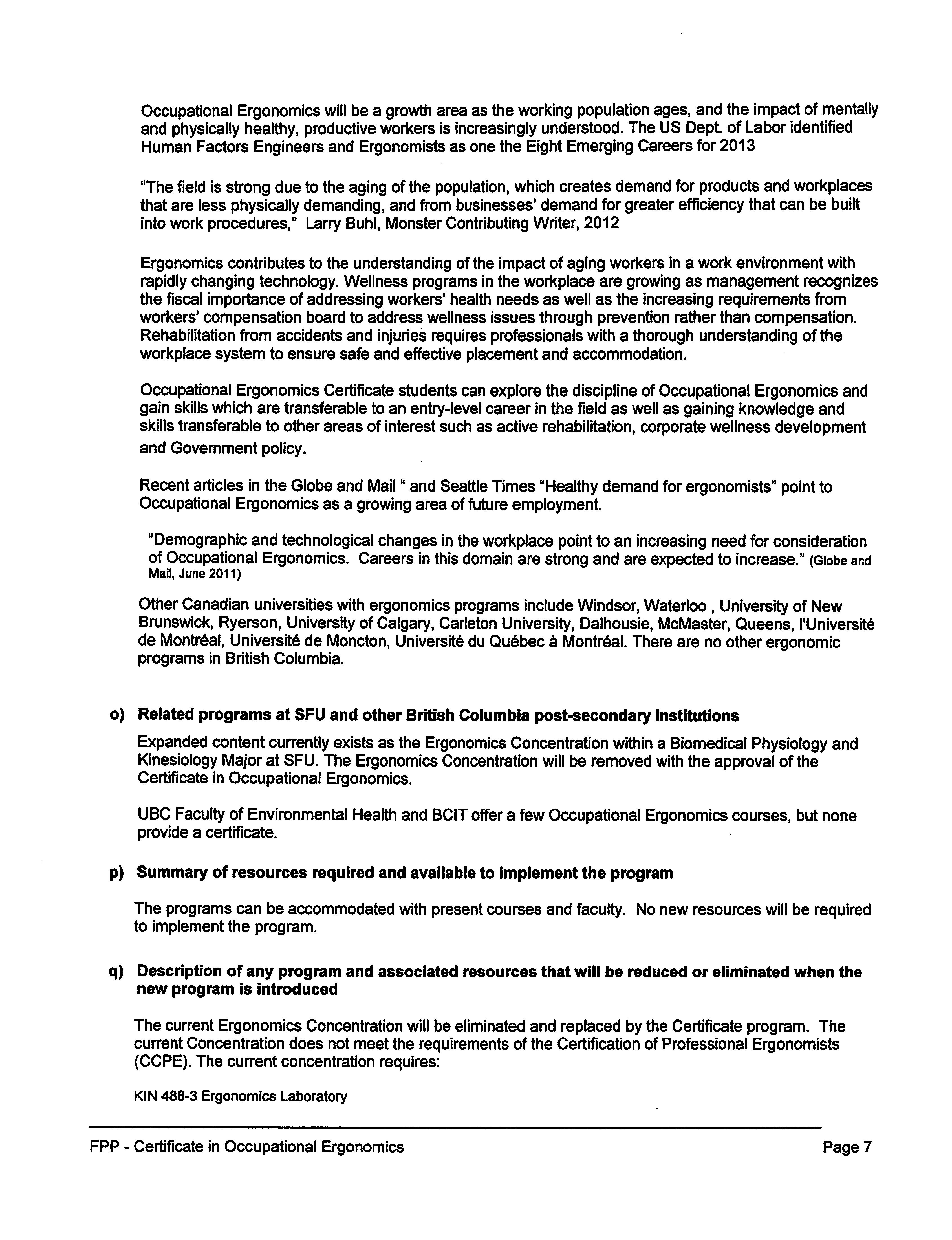SFU
MEMORANDUM
()I'FICK ()!•'
IIII
•: VIC1--PRKSIDKNT, ACADEMIC AND PR< )V<)ST
University Drive,
Burnaby,
BC
Canada V5A 1S6
TEL: 778.782.3925
FAX: 778.782.5876
www.sfu.ca/vpacadcniic
attention
Senate
date
June 19,2013
from
)on Driver, Vice-President, Academic and
PAGES
1/1
Provost, and Chair, SCUP
RE:
Faculty of Science: Full ProgramProposal for an Occupational Ergonomics Certificate in the
Department of
Biomedical Physiology and Kinesiology (SCUP 13-28)
At itsJune 19, 2013 meeting, SCUP reviewed and approved the Full Program Proposal for an
Occupational Ergonomics Certificate in the Department of Biomedical Physiology and Kinesiology within
the Faculty of Science, effective Spring 2014.
Motion:
That Senate approve and recommend to the Board of Governors the Full Program Proposal for an
Occupational Ergonomics Certificate in the Department of Biomedical Physiology and Kinesiology within
the Faculty of Science, effective Spring 2014.
c:
R. Dill
A. Arnold
SIMON
FRASER
UNIVERSITY
ENGAGING THE WORLD
S.13-96
SFU
MEMORANDUM
ATTENTION
FROM
RE:
SCUP 13-28
OFFICE OF THE ASSOCIATE VICE-PRESIDENT, ACADEMIC
8888 University Drive,
TEL: 778.782.4636
avpcio(r3sfu.ca
Burnaby, BC
www.sfu.ca/vpacademic
Canada V5A1S6
Senate Committee on University
Priorities
Gordon Myers, Chair
Senate Committee on Undergraduate
Studies
Faculty of Science (SCUS 13-28b)
date
June 7, 2013
PAGES
I/]
Action undertaken by the Senate Committee on Undergraduate Studies at its meeting of
June 8, 2013, gives rise to the following recommendations:
Motion
That SCUP approve and recommend to Senate the Full Program Proposal for the
Occupational Ergonomics Certificate in the Department of Biomedical Physiology
and Kinesiology within the Faculty of Science.
The relevant documentation for review by SCUP is attached
SIMON FRASER UNIVERSITY
engaging the world
Full Program Proposal
Occupational Ergonomics Certificate
Department of Biomedical Physiology and Kinesiology
Undergraduate Program Committee
Simon Fraser University
April 19th, 2013
Executive Summary
•
The latest Biomedical Physiology and Kinesiology external review (2011) recommended focusing our
teaching resources in ergonomics towards a "limited number ofcourses focused onoccupational
ergonomics and rehabilitation".
•
The proposed Occupational Ergonomics Certificate addresses the external review committee's concerns
by offering a targeted collection of courses in occupational application.
•
Occupational Ergonomics has been determined to be ofinterest to students and ofsignificant, growing
demand in the labor market. While only one or two students graduate in our Ergonomics Concentration
each year, our courses in this area run yearly with more than fifty students enrolled.
•
Identifying this collection ofcourses with acertificate designation is important for students entering the
labor market, particularly those that cannot meetthe full requirements for professional certification but
who will be able to incorporate ergonomics into their skill set. It isalso important for former graduates of
Kinesiology program who are encouraged by employers to add totheir skill set bytaking the certificate.
•
Employers are increasingly encouraging professional certification in Ergonomics. The Canadian College
for theCertification of Professional Economists (CCPE) requires a significant number of lecture hours
directly related toergonomics for professional certification. The Department ofBPK is no longer able to
teach all ofthe courses in the areas previously incorporated into the Ergonomics Concentration (Major
Program) dueto limited resources. Students' perception ofthe Ergonomics Concentration hasalso been
that it is quite onerous.
•
Theproposed Occupational Ergonomics Certificate will provide a significant portion oftheeducation
hours required for CCPE certification. Students could choose specific electives and extra courses from
within, and outside, the Department of BPK to meet the requirements of CCPE certification ifdesired.
This volume ofwork, however, would be beyond the expectations ofa Bachelors degree (fifty eight upper
division units to meet SFU requirementsand CCPEcertification - based on the last time we offereda
program that met certification (2008)).
•
Students will normally be Kinesiology Majors and will apply for admission into theOccupational
Ergonomics Certificate.
•
The proposal addresses the SFU vision ofbeing research-driven, student-centered and community-
engaged.
•
The Undergraduate Program Committee ofthe Department of Biomedical Physiology and Kinesiology will
direct the program.
•
Graduates with the Occupational Ergonomics Certificate will have career ready skills and will be well
prepared to move on to:
FPP - Certificate in Occupational Ergonomics
Page 1
Employment in careers that address health and wellness in the workplace such as: corporate or
research ergonomist, return towork specialists, workplace wellness professionals, and policy
development.
The Occupational Ergonomics Certificate will meet a significant portion of the Professional
Certification Requirements of the Association of Canadian Ergonomists.
Professional degrees in Occupational Therapy, Physical therapy, Industrial Hygiene, etc.
Graduate degrees in related areas.
Background
The Department of Biomedical Physiology and Kinesiology (BPK) has offered an opportunity for students to
study and apply their knowledge in the specialized area of Ergonomics/ Human Factors since the department's
inception. Many graduate and undergraduate students have completed their BPK degrees with an
Ergonomics specialty and have continued on to be leaders in the Ergonomics field in research, policy and
industry.
Over the years the Ergonomics offerings have changed to reflect the interests and availability of faculty and
students resulting, in recent years, in an Ergonomics Concentration within the BPK BSc. Major. This
Concentration
was designed to provide a broad foundation in the area of Ergonomics/Human Factors
(occupational ergonomics, environmental ergonomics,
computer interaction, product design, and
organizational design) in an effort to meet the significant number of lecture hours directly related to ergonomics
required for professional certification by the Canadian College for the Certification of Professional Ergonomists
(CCPE) which is increasingly being encouraged by employers. Efforts to re-design
the current Ergonomics
Concentration to accommodate CCPE requirements have been hampered by an inability to offer courses
consistently (due to faculty retirements which have not been replaced) as well as by a perception by students
that the requirements to complete the concentration are too onerous. Efforts to share resources with other
departments (cross listing) and creative scheduling have not resulted in increased enrolment despite student
interest and strong employment prospects in the field.
The proposed Occupational Ergonomics Certificate is a streamlined offering of current courses that will provide
a significant portion
of the CCPE education hours required. For many students who do not intent to be full
ergonomists, but only apply some parts of the practice in their professions (physiotherapy, return to work etc.),
the certificate will serve to identify their expertise to potential employers. Students who wish to fully specialize
in the field ergonomics could choose specific electives and extra courses from within, and outside, the
Department of BPK to meet the requirements of CCPE certification if desired. This volume of work, however,
would be beyond the expectations of a Bachelors degree.
The proposed certificate is directed at the study of the workplace, a prime area of interest of BPK students,
and a targeted labour market growth area. Occupational health issues in general, and ergonomics in specific,
is a key application area for Kinesiologists as they strive to create healthy individuals, organizations and
environments in a future workplace of aging, diverse workers and rapid technological change. By focusing our
offerings in this key area we can provide students with the knowledge they need to excel while allowing them
to complete their studies in a timely manner.
FPP- Certificate in Occupational Ergonomics
Page 2
Withthe proposed changes, itcan be reasonably expected that the number of students drawn to the new
Certificate
will exceed the numbers of students currently drawn to the existing concentration of Ergonomics
within the Kinesiology Major.
1.
Credential to be awarded:
Occupational Ergonomics Certificate
2.
Location:
SFU, Burnaby Campus
3.
Faculty/Department/School offering the new program:
Faculty of Science/ Department of Biomedical
Physiology and Kinesiology
4.
Anticipated program start date:
January 2014
5.
Description of proposed program:
a) Aims, goals, and/or objectives
The intent ofthis proposal is to consolidate the current Ergonomics Concentration course offerings into a
streamlined, and career focused Ergonomics Certificate, which addresses student demand for essential
foundations in the Occupational Ergonomics discipline. The new certificate will eliminate three
undersubscribed courses currently in the Ergonomics Concentration (BPK 488, BPK 486 and BPK 380) and
distill critical Occupational Ergonomics related material into one new course(BPK 482). This change will
meet several objectives:
•
Prepare students toaddressthedemographic and technological changes in theworkplace through
the exploration of the science and application of Occupational Ergonomics;
•
Provide a mechanism for students toexplore the discipline ofErgonomics without having tocommit to
a full concentration;
•
Focus pedagogy onOccupational Ergonomics-related issues which have been identified by BPK
students as a gap in their education;
Provide consistent, reliableofferings of keycourses;
Providecommunity engagement through practicum placements;
Eliminate undersubscribed courses without losing content critical tostudent development.
Meet the needs ofthe labor market
•
•
•
•
b) Anticipated contribution to mandate and strategic plan of the institution
The proposed certificate mesheswell with the SFU vision and strategic plan ofthe BPK Department.
i)
Research-driven, Student-centered, Community-engaged
The certificate proposes to betteruse the resources already existing within the department to combine a set
of courses that engages boththe student and the workplace communities. The certificate will address
students' concernsofwanting to complete courses more quickly with purposeful, career-ready content and
will provide employers with students who havethe ability to translateknowledge into practice.
ii) External Review
The proposal also strives to meet the recommendations of the recent BPK external review which identified
the Ergonomics specialization as under-enrolled as a program of study
perse.
The Review Team
recommended that the Department facilitate the "incorporation of a limited number of ergonomicscourses
focused on occupational and rehabilitation into the active health and rehabilitation area of concentration".
FPP- Certificate in Occupational Ergonomics
Page 3
"The Review Team recommends that the Department make astrategic decision regarding the extent to which they
wish to support theergonomics component ofthe undergraduateprogram
Elimination of the formal
stream/specialization as it currently exists (as a conduit toward preparing students tomeet professional standards)
seems inevitable without a major commitment ofresources. Incorporation ofa limited number of ergonomics
courses focusedon occupational and rehabilitation into the active health and rehabilitation area ofconcentrationis a
reasonable approachgiven the current availability of resources ..."
This proposal addresses this recommendation.
c) Target audience
The target audience for the proposed Occupational Ergonomics Certificate is primarily current BPK
students inthe Kinesiology Major. While BPK students continueto express interest inthe discipline of
Ergonomics, and the career market is strong, students have not committed to the concentration
largely due
to the excessive number of courses required (more credits than other concentration) and lack of consistent
course offerings. By providing the more focused and streamlined Occupational Ergonomics Certificate,
students can explore the discipline of Occupational Ergonomics and gain skills which are transferable to an
entry-level career in the field
as well as gaining knowledge and skills transferable to other areas of interest
such as active rehabilitation, corporate wellness development and Government policy.
A secondary target audience is professionals practicing in the areas of occupational rehabilitation,
corporate wellness, and occupational health and safety who want to augment their knowledge and skills in
the area of Ergonomics to meet corporate goals and/or achieve the requirements for certification or
continuing education credits required by professional associations.
d) Content
The Occupational Ergonomics Certificate willrequire 24 credits, 12 of which are required, with the
remaining 12 selected from a list of electives.
Prerequisite and Required Course Grades
Students enrolling in biomedical physiology and kinesiology courses must have a grade of C- or better in
prerequisite
courses. Students enrolled in this certificate program must have grade of C- or better in all
required courses.
Program Requirements
Students complete all of
BPK 180W Introduction to Ergonomics(3)
BPK 381 Psychology of Work(3)
BPK 481 Activity-Generated Musculoskeletal Disorders(3)*
BPK 482 Ergonomics and Rehabilitation^)*
and four of
BPK 303 Kinanthropometry(3)
BPK 382 Workplace Health and Safety(3)
BPK
310 Exercise/Work Physiology(3)
BPK 343 Active Health: Assessment and Programming(3)
BPK 402 Mechanical Properties of Tissues(3)
BPK 415 Neural Control of Movement(3)
FPP - Certificate in Occupational Ergonomics
Page 4
BPK 426 Neuromuscular Anatomy(3)
BPK
448 Rehabilitation of Movement Control(3)
BPK 484 Altitude and Aerospace Physiology(3)
BPK 496 Directed Studies I(3)#
BPK 498 Directed Studies II (3)#
* course requires additional pre-requisites
*course must be in area related to Occupational Ergonomics
e) Delivery Methods
All of the courses are already in place and consist of lecture/lab/tutorial except for
BPK
482, which is under
development. This course
will cover essential material from courses slated to be eliminated and will be
delivered in a lecture/practicum format.
f) Linkages between learning outcomes and curriculum design
The learning outcomes for the Occupational Ergonomics Certificate include:
Develop a framework of strategies to facilitate life-long learning in the discipline of Ergonomics
Engage systems analysis techniques to address ergonomic concerns in the workplace
Analyze the
range of user needs, limitations and capabilities within the workplace
Appreciate
the importance of multidisciplinary approaches to problem solving in the workplace
Use best practices to select defensible assessment tools and solutions
Translate research-based knowledge of Ergonomics to the workplace
Integrate ergonomics
strategies to develop healthy individual, organizations and environments
These outcomes will be met by engaging a variety of formative and summative tools to create
a
student-
centered learning environment. Teaching tools
will vary from course to course and will include:
Case studies
Problem based computer simulations
Practicum and portfolios
Role playing
Debates
Lectures
Peer teaching
Lab activities
Reflections
FPP - Certificate in Occupational Ergonomics
Page 5
g) Distinctive characteristics
The Occupational Ergonomics Certificate will be distinct from any other certificate/program within the
University and is more comprehensive than any other Occupational Ergonomics program in British
Columbia.
h) Anticipated completion time
The certificate is intended to be completed within the four year BSc and could also be completed in a
minimum of two years by a professional returning to the program.
i)
Enrolment plan for the length of the program
The admission requirements will be the same as for the Major in Biomedical Physiologyand Kinesiology.
There will be an option for students already registered at SFU to transfer to the program, as long as they
fulfill the qualification criteria. Initially, it is anticipated that approximately 30 students per academic year
would be attracted to the program.
j) Policies on student evaluation
Students will be evaluated as per general regulations of Simon Fraser University and the Facultyof
Science.
k) Policies on faculty appointment (minimum qualifications)
Continuing faculty will hold a minimum of an MSc or equivalent
I) Policies on program assessment
All academic units at SFU are subject to external review every seven years.
m) Levelof support and recognition from other post-secondary institutions (including plans for
admission and transfer within BC) and relevant regulatory or professional bodies
As perSFU'stransfer credit procedures, students may transfer from BC colleges or universities to enroll
into this program. The Occupational Ergonomics Certificate will meet
a
significant portion ofthe
Professional Certification Requirements of the Association of Canadian Ergonomists.
n) Evidence of student interest and labour market demand
Currently the proposed required courses in the certificate attract about 50 students each per academic year
(BPK180W Introduction to Ergonomics, BPK 381 Psychology ofWork, BPK 481 Activity-Generated
Musculoskeletal Disorders).
This certificateshifts the focus of our ergonomic teaching towards occupational ergonomics and will
include courses that are of interest to and will count as electives for all Kinesiology Majors. As there are
about 100 graduates from the Kinesiology Major per year, itis anticipated that many ofthese students will
see the value in completing the certificate in occupational ergonomics.
Many graduate and undergraduate students have completed their BPKdegrees with an Ergonomics
specialtyand have continued on to be leaders inthe Ergonomics
field in research, policy and industry.
Positions have been filled within Federal and Provincial governments, Workers Compensation Boards,
Health Authorities, large manufacturing companies (NOKIA, RIM, Ford etc.), insurance companies and
large service sector corporations.
FPP - Certificate in Occupational Ergonomics
Page 6
Occupational Ergonomicswill be a growth area as the working population ages, and the impactof mentally
and physically healthy, productiveworkers is increasingly understood. The US Dept. of Labor identified
Human Factors Engineers and Ergonomists
as one the Eight Emerging Careers for 2013
"The field is strong due to the aging of the population, which creates demand for products and workplaces
that are less physicallydemanding, and from businesses' demand for greater efficiency that can be built
into work procedures," Larry Buhl, Monster Contributing Writer, 2012
Ergonomics contributes to the understanding of the impact of aging workers in a work environment with
rapidly changing technology. Wellness programs in the workplace are growing as management recognizes
the fiscal importance of addressing workers' health needs as well as the increasing requirements from
workers' compensation board to
address wellness issues through prevention rather than compensation.
Rehabilitation from accidents
and injuries requires professionals with a thorough understanding of the
workplace system to ensure safe and effective placement and accommodation.
Occupational Ergonomics Certificate students can explore the discipline of Occupational Ergonomics and
gain skills which are transferable to an entry-level career in the field as well as gaining knowledge and
skills transferable to other
areas of interest such as active rehabilitation, corporate wellness development
and Government policy.
Recent articles in the Globe and Mail" and Seattle Times "Healthy demand for ergonomists" point to
Occupational Ergonomics as a growing area of future employment.
"Demographic and technological changes in the workplace point to an increasing need for consideration
of Occupational Ergonomics. Careers in this domain are strong and are expected to increase."
(Globe and
Mail, June 2011)
Other Canadian universities with ergonomics programs include Windsor, Waterloo , University of New
Brunswick, Ryerson, University of Calgary, Carleton University, Dalhousie, McMaster, Queens, I'Universite
de Montreal, Universite de Moncton, Universite du Quebec a Montreal. There are no other ergonomic
programs in British Columbia.
o) Related programs at SFU and other British Columbia post-secondary institutions
Expanded content currently exists as the Ergonomics Concentrationwithin a Biomedical Physiology and
Kinesiology Majorat SFU. The Ergonomics Concentration will be removed with the approval of the
Certificate in Occupational Ergonomics.
UBC Faculty of Environmental Health and BCIT offer a few Occupational Ergonomics courses, but none
provide a certificate.
p) Summary of resources required and available to implement the program
The programs can be accommodated with present courses and faculty. No new resources will be required
to implement the program.
q)
Description of any program and associated resources that will be reduced or eliminated when the
new program is introduced
The current Ergonomics Concentration will be eliminated and replaced by the Certificate program. The
current Concentration does not meet the requirements of the Certification of Professional Ergonomists
(CCPE). The current concentration requires:
KIN 488-3 Ergonomics Laboratory
FPP - Certificate in Occupational Ergonomics
Page 7
KIN 380-3 Occupational Biomechanics
6 units
and three of*
KIN 303-3 Kinanthropometry
KIN 310-3 Exercise/Work Physiology
KIN 381-3 Psychology of Work
KIN 382-3 Workplace Health
KIN481-3 Activity-Generated Musculoskeletal Disorders
IAT333-3 Interaction Design Methodsf
IAT334-3 Interface Designt
IAT432-3 Design Evaluation
12 units
The remaining five courses inthe above listthat are not used, may be used as electives (see electivescourse list below).
and six of
GERO 401-3 Aging and the Built Environment
KIN 343-3 Active Health: Assessment and Programming
KIN 367-3 Psychology of Motor SkillAcquisition
KIN 402-3 Mechanical Properties of Tissues
KIN 415-3 Neural Control of Movement
KIN 416-3 Control of Limb Mechanics
KIN 442-3 Biomedical Systems
KIN 448-3 Rehabilitation of Movement Control
KIN 461-3 Physiological Aspects of Aging
KIN 467-3 Human Motor Control
KIN 484-3 Altitude and Aerospace Physiology
KIN 485-4 Human Factors in the Underwater Environment
KIN420-3 Selected Topics I*
KIN 421-3 Selected Topics II*
KIN 422-3 Selected Topics III*
KIN423-3 Selected Topics IV*
KIN 496-3 Directed Studies I*
KIN 498-3 Directed Studies II*
frequires additional prerequisites
*can be counted towards area of concentration ifrelevant to ergonomics or human factors. 18 units
Total 52 units
Afurther 10 lower or upperdivision units ofelectives maybe completed from any discipline within the university.
r)
List of faculty members teaching and supervising
Faculty
Teaching/Supervising
Percentage
Areas of Specialization
Anne-Kristina Arnold
Teaching/Supervising
100% (50% appointment)
Ergonomics
Stephen Brown
Teaching/Supervising
50%
Health/Ergonomics
Anthony Leyland
Teaching
10%
Biomechanics/Ergonomics
Ryan Dill
Teaching
10%
Active Health
6.
Additional Information Required by SFU:
a) Contact information for the faculty member responsible for program development
Anne-Kristina Arnold, Biomedical Physiology and Kinesiology, aarnolda@sfu.ca
Ryan Dill, Biomedical Physiology and Kinesiology, rvand@sfu.ca
GlenTibbits, Biomedical Physiology and Kinesiology, tibbits@sfu.ca
FPP - Certificate in Occupational Ergonomics
Page 8
The following would be the calendar entry for this program.
Occupational Ergonomics Certificate Program
The Occupational Ergonomics Certificate will require 24 credits, 12 of which are required, with the
remaining 12 selected from a list of electives.
Admission Requirements
Admission is governed by the University'sadmissions regulations. After University admission, submission
of a completed program approval form to the biomedical physiology & kinesiology
academic advisor is
required for formal acceptance in the program.
The certificate is normally completed withinfive years of admission to the certificate program.
Units applied to one certificate may not be applied to another certificate or diploma.
Prerequisite and Required Course Grades
Students enrolling in biomedical physiology and kinesiology courses must have a grade of C- or better in
prerequisite courses. Students enrolled in this certificate program must have grade of C- or better in all
required courses.
Program Requirements
Students must have a minimum 2.00 grade point average (GPA) calculated on all required courses.
Students complete all of
BPK 180W Introduction to Ergonomics(3)
BPK 381 Psychology of Work(3)
BPK 481 Activity-Generated Musculoskeletal Disorders^)*
BPK 482 Ergonomics and Rehabilitation^)*
and four of
BPK 303 Kinanthropometry(3)
BPK 382 Workplace Health and Safety(3)
BPK 310 Exercise/Work Physiology(3)
BPK 343 Active Health: Assessment and Programming(3)
BPK 402 Mechanical Properties of Tissues(3)
BPK
415 Neural Control of Movement(3)
BPK 426 Neuromuscular Anatomy(3)
BPK
448 Rehabilitation of Movement Control(3)
BPK 484 Altitude and Aerospace Physiology(3)
BPK 496 Directed Studies I(3)#
BPK 498 Directed Studies II (3)*
* course requires additional pre-requisites
*course must be in area related toOccupational Ergonomics
FPP - Certificate in Occupational Ergonomics
Page 9
Back to top
